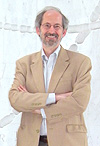Bob Wilson elected co-spokesperson for LBNE
 |
|
Bob Wilson
|
When Bob Wilson was an undergraduate student studying condensed matter physics at the University of London, the UK native was nonetheless drawn to the United States by a long-held fascination with high-energy physics.
Fast forward more than 30 years, and Wilson now has an active research group and teaches physics at Colorado State University. And starting Jan. 1, he will step into the role of spokesperson for the largest planned high-energy physics experiment in the United States.
Wilson was elected to the position of co-spokesperson for the Long-Baseline Neutrino Experiment in November. He will replace outgoing spokesperson Bob Svoboda of UC Davis and will join Brookhaven National Laboratory's Milind Diwan in leading the LBNE collaboration.
"It's an exciting time," he said. "Although I don't start officially until the beginning of the year, my calendar is already a lot fuller. My responsibilities include ensuring that as the project technology develops, it does so in way that keeps the science goals of the collaboration front and center."
In many ways, Wilson's involvement with LBNE is just the next step in a decades-long journey of fascination with the fundamental nature of the universe. Ultimately, he decided to attend graduate school in the United States, at Purdue University. He has worked on numerous projects at the Stanford Linear Accelerator Center and currently works on the T2K long-baseline neutrino experiment in Japan.
Why do neutrinos fascinate him? Well, they didn't always, he said. When he was an undergraduate, neutrino physics was "the boring part of the textbook to me." But the past 20 years, he said, has seen that notion turned upside down. Neutrinos may now even hold the key to explaining why the universe is primarily made of matter, instead of equal parts matter and antimatter.
With LBNE, Wilson hopes scientists will see even more mysteries opened up.
"Neutrinos have proven to be chock-full of surprises, and I'm hoping they've got a few more up their sleeve," he said. "The only way to find out is with a large-scale experiment like LBNE."
On Monday, the U.S. Department of Energy granted CD-1 approval to LBNE's first phase, which will see a beamline built at Fermilab and a far detector constructed near Sanford Lab in Lead, S.D. This approval, Wilson said, will help the collaboration recruit more international partners to advance the project's long-term science goals.
With Wilson's election, Svoboda's time as spokesperson is nearing an end. Svoboda and Diwan were elected in 2010 as LBNE's first co-spokespersons, and Svoboda has worked on neutrino experiments like LBNE for more than 25 years. The collaboration, Diwan said, is grateful for his efforts.
"It has been a rewarding experience for me to work with Bob Svoboda, who has been tireless in promoting the scientific program for LBNE and in organizing the collaboration," Diwan said.
—Andre Salles
|